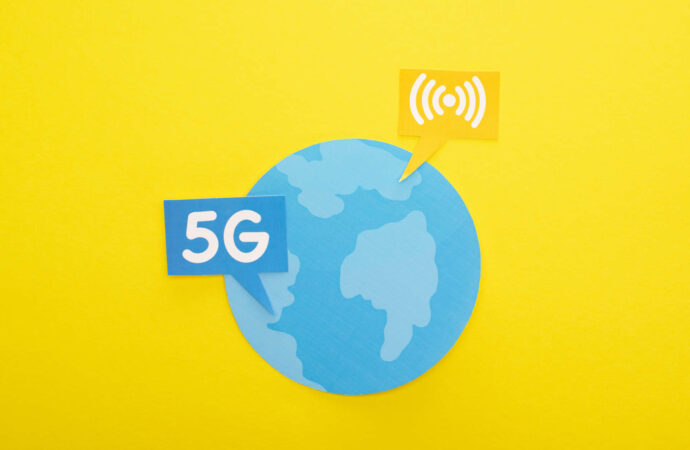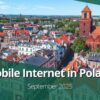To say that 5G technology will change our lives is an understatement. Instead of such obvious statements, it’s worth citing numbers that perfectly illustrate the scope of this global mobile revolution. By the end of 2024, nearly two billion people worldwide will be using 5G connections[1].
However, this impressive number is just the tip of the iceberg. In this article, we will examine how this groundbreaking technology is shaping the development of different regions around the world and what implications it holds for our shared future. From smart cities in Asia, through automated factories in Europe, to telemedicine in North America—5G is becoming a catalyst for progress on a global scale.
North America
United States
The United States is considered a leader in deploying fifth-generation networks. The USA has made significant progress in implementing 5G. By the beginning of 2024, major operators like Verizon, AT&T, and T-Mobile have expanded their 5G services so broadly that it is estimated over 75% of American subscribers have access to it[2]. Another priority of the American administration is investing in infrastructure to improve connectivity in rural areas. An allocation of 65 billion dollars is planned for this purpose, primarily focusing on the development of broadband networks, including 5G, over the next few years[3].
Canada
Canada is another North American country that regularly invests in the 5G network. Telecommunications companies like Rogers, Bell, and Telus offer 5G services in over 50 cities and towns[4]. The Canadian government is releasing additional spectrum frequencies to accelerate deployment. The goal is to achieve 70% coverage among Canadian residents by the end of 2024. Interestingly, the first examples of commercial use of 5G technology in various industries are already available. Sectors like mining and agriculture are beginning to use 5G to increase efficiency and safety.
Europe
United Kingdom
After leaving the European Union, the United Kingdom is making noticeable progress in deploying 5G. Operators such as EE, Vodafone, O2, and Three have introduced 5G to over 200 cities[5]. The British government’s goal is to achieve 95% geographical coverage of the 5G network by 2025. Covering virtually the entire territory of the UK with fifth-generation networks is expected to be possible thanks to investments in infrastructure and simplification of regulations. The NHS, the British health service, is already using 5G for telemedicine, and the transport industry is exploring the possibilities of autonomous vehicles.
Germany
Germany can boast one of the most developed 5G networks in Europe. Providers like Deutsche Telekom, Vodafone Germany, and Telefónica Deutschland offer access to innovative technology to over 80% of the population[6]. There are ambitious plans to achieve 99% household coverage by 2025. The German industry, famous for its efficiency, is implementing 5G for smart factories and advanced logistics processes. This brings tangible benefits—especially during the period of noticeable economic slowdown in Germany.
France
The driving force behind the development of 5G along the Seine are operators like Orange, SFR, Bouygues Telecom, and Free Mobile. By mid-2024, 5G services were available in over 3,000 municipalities[7]. The government conducted a spectrum auction in the 3.5 GHz band to accelerate the deployment of 5G in France. The main emphasis from the public administration is on ensuring that the development of 5G complies with environmental standards and public health guidelines, supporting the latest EU regulations in this area.
Asia-Pacific
China
China is the main competitor of the United States in the race for the title of leader in 5G deployment. By 2024, the Middle Kingdom had installed over 1.2 million 5G base stations and already has over 600 million subscribers[8]. Companies like China Mobile, China Unicom, and China Telecom have built extensive networks adapted for data transmission in the fifth-generation standard. 5G technology is deeply integrated with manufacturing, healthcare, and transportation, driving progress in artificial intelligence and the Internet of Things (IoT). It’s worth recalling that in the background, there is a trade war between China and the USA, of which an important aspect is the elements of 5G infrastructure.
South Korea
South Korea was one of the first countries to launch commercial 5G services in 2019, and South Korean companies and institutions continue to be leaders in terms of coverage and innovation. Operators like SK Telecom, KT Corporation, and LG Uplus offer nationwide and affordable access to 5G networks. Already over 90% of mobile users in South Korea have access to 5G[9]. The country is a testing ground for smart cities, particularly evident in the Seoul metropolitan area.
Japan
The Land of the Rising Sun quickly expanded its 5G infrastructure, spurred by the upcoming Osaka Expo 2025. Thanks to the collaboration of mobile operators—including NTT Docomo, KDDI, SoftBank, and Rakuten Mobile—5G services have been introduced to every prefecture. Altogether, 5G coverage now reaches over 60% of the population[10]. Japan focuses on enhancing mobile broadband services and pioneering innovations in robotics and virtual reality.
Middle East
United Arab Emirates
The United Arab Emirates are known for a rapid technological leap over the past decades. Also in terms of 5G deployment, they can be considered a regional leader. The main telecommunications service providers, Etisalat and du, have already achieved over 80% population coverage in this desert country[11]. The country is using 5G to develop smart city projects, including autonomous transport and enhanced public safety, in line with a coherent and long-term national development vision.
Saudi Arabia
Saudi Arabia is investing heavily in 5G as part of its Vision 2030 plan. Operators like STC, Mobily, and Zain offer 5G services to over 60% of Saudi subscribers[12]. This technology supports key sectors such as oil and gas, mining, and tourism, improving efficiency through better connectivity and IoT applications.
Africa
South Africa
The Republic of South Africa is considered the most developed country in terms of 5G deployment on the African continent, which is one of the most backward regions in this respect. Companies like Vodacom and MTN have recently launched services in major cities like Johannesburg, Cape Town, and Durban. By 2024, about 15% of the population will have access to 5G[13], with plans for further development. 5G has the potential to improve internet access and drive economic growth. As we can see, South Africa and other African countries still have many years ahead to catch up with the developed parts of our globe.
Nigeria
Nigeria, although it’s the most populous country in Africa, is just beginning to work on large-scale 5G deployment. The Nigerian Communications Commission has so far issued licenses to operators like MTN Nigeria and Mafab Communications to carry out this task. Pilot programs are starting in cities like Lagos and Abuja. It is expected that 5G will help meet connectivity challenges and support sectors such as education and healthcare[14].
Latin America
Brazil
Brazil is accelerating the deployment of 5G networks after successful frequency auctions in the 3.5 GHz band. Operators like Claro, Vivo, and TIM are deploying networks in key urban areas, aiming to cover all state capitals by the end of 2024[15]. Residents of 27 of Brazil’s most important cities will then gain access to 5G. The government views 5G as a driving force for digital transformation in various industries, which will help Brazil overcome the stagnation felt since the COVID-19 pandemic.
Mexico
Mexico is expanding its 5G infrastructure with operators like Telcel and AT&T Mexico. The situation in this country is decidedly more challenging than in other, wealthier North American countries—Canada and the USA. Nevertheless, the Mexican government is not giving up and is consistently implementing a strategy for deploying fifth-generation technology. According to its plans, by mid-2024, 5G services should be available in major cities, including Mexico City, Monterrey, and Guadalajara. To harness the full economic potential, emphasis in 5G implementation is placed on improving mobile broadband connectivity and exploring applications in smart cities and industrial automation[16].
Challenges and Opportunities
The speed of progress in 5G deployments worldwide is surprising and impressive. Nevertheless, much remains to be done, and challenges persist. The most important include:
- Infrastructure Costs: Building 5G networks requires significant investments. Global expenditures on 5G deployment are expected to reach substantial amounts by 2025. Current estimates suggest that total investments in 5G infrastructure will amount to approximately 600 to 650 billion dollars by 2025. This growth is driven by regions like Asia and the Pacific, North America, and Europe, where countries are intensively investing in 5G networks to support advances such as IoT, smart cities, and Industry 4.017.
- Spectrum Allocation: Efficient spectrum management is crucial. Delays in auctions and spectrum release can hinder deployment.
- Security Concerns: Increased connectivity brings heightened cyber risks, necessitating robust security measures.
- Regulatory Differences: Regulations regarding 5G deployment differ significantly between the USA and the EU, affecting international cooperation in this area. In the USA, a ban on using Huawei equipment has been introduced for national security reasons, while in the EU, the policy is more varied—some countries, like Germany, allow the use of Chinese technology provided security standards are met. Additionally, the USA focuses on using higher frequencies, such as mmWave, which provide higher speeds but less coverage, while the EU prefers lower bands that offer better coverage at the expense of speed. An essential difference is also the approach to net neutrality—the USA has relaxed regulations, allowing operators to differentiate services, while the EU maintains a more restrictive policy, imposing an obligation to treat internet traffic equally.
Impact on Industries
5G technology is set to revolutionize multiple sectors:
- Healthcare: Enables remote surgeries and telemedicine, improving access to medical services, especially in remote areas18.
- Manufacturing: Supports automation and real-time analytics, leading to smarter factories and increased productivity.
- Transportation: Facilitates the development of autonomous vehicles and smarter traffic management systems.
- Entertainment: Enhances AR and VR experiences, transforming gaming, education, and live events.
Looking Ahead
As we progress through 2024, expanding 5G coverage remains a global priority. Investments in research and development aim to unlock new applications and services. Discussions around 6G technology are beginning, promising even faster speeds and more reliable connections in the future19.
Conclusion
The global rollout of 5G is reshaping the digital landscape, offering faster and more reliable connectivity. While challenges exist, the benefits drive nations to invest and collaborate. As 5G becomes more widespread, it will unlock new opportunities and transform how we live and work, bringing us closer to a fully connected global society.
Sources:
- 5G Americas: “Global 5G Connections Reaches Nearly Two Billion”
- Forbes: “The State of 5G In The US And How It Might Improve”
- Ericsson Mobility Report June 2024
- GSMA Intelligence: “The State of 5G” (2024)
Footnotes
- 5G Americas: “Global 5G Connections Reaches Nearly Two Billion” ↩
- Ericsson Mobility Report June 2024 ↩
- Forbes: “The State of 5G In The US And How It Might Improve” ↩
- GSMA Intelligence: “The State of 5G” (2024) ↩
- Ericsson Mobility Report June 2024 ↩
- GSMA Intelligence: “The State of 5G” (2024) ↩
- Ericsson Mobility Report June 2024 ↩
- GSMA Intelligence: “The State of 5G” (2024) ↩
- Ericsson Mobility Report June 2024 ↩
- GSMA Intelligence: “The State of 5G” (2024) ↩
- Ericsson Mobility Report June 2024 ↩
- GSMA Intelligence: “The State of 5G” (2024) ↩
- Ericsson Mobility Report June 2024 ↩
- GSMA Intelligence: “The State of 5G” (2024) ↩
- Ericsson Mobility Report June 2024 ↩
- GSMA Intelligence: “The State of 5G” (2024) ↩
- Ericsson Mobility Report June 2024 ↩
- GSMA Intelligence: “The State of 5G” (2024) ↩
- Ericsson Mobility Report June 2024 ↩










Leave a Comment
Your email address will not be published. Required fields are marked with *